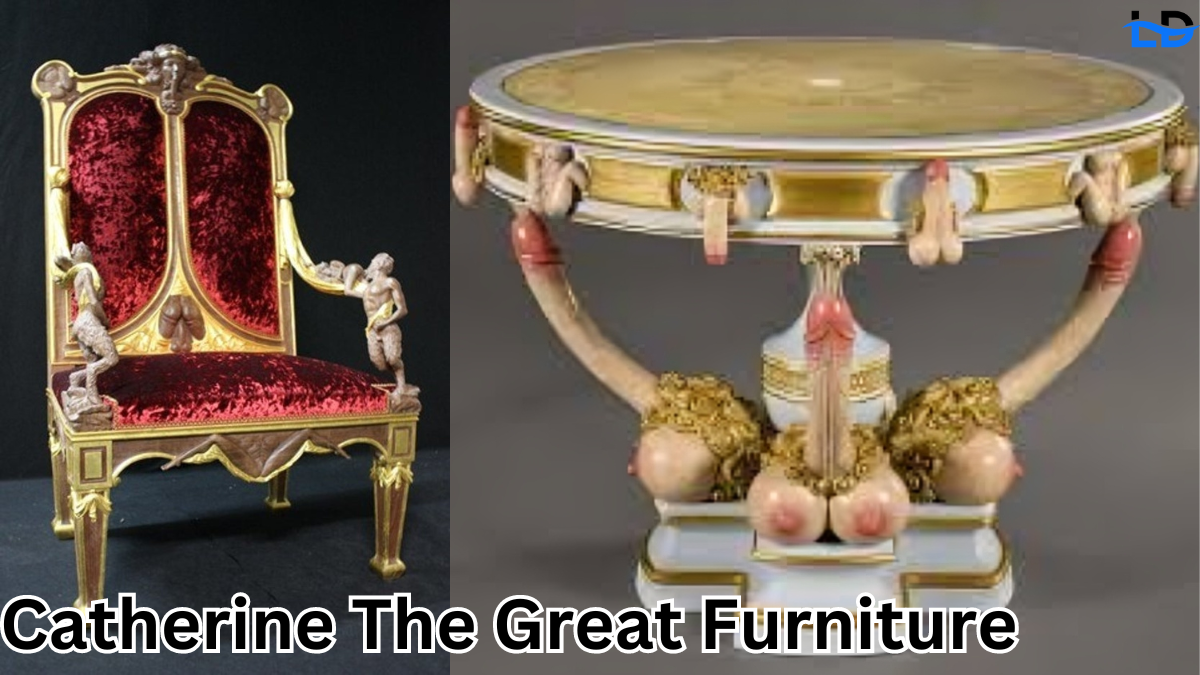Catherine the Great and Her Legacy in Furniture Design

Catherine the Great, Empress of Russia from 1762 until her death in 1796, is a towering figure in history, renowned not only for her political acumen and expansive territorial ambitions but also for her cultural and artistic contributions. Among her many legacies, her influence on furniture design stands out as a reflection of her taste, vision, and the broader cultural shifts of her era. This article delves into the intricate world of Catherine the Great’s furniture, exploring its historical context, design characteristics, and lasting impact.
The Historical Context: Russia in the 18th Century
1. The Enlightenment Influence
Catherine the Great was an ardent admirer of the Enlightenment, a philosophical movement that emphasized reason, individualism, and a scientific approach to knowledge. This intellectual shift deeply influenced European art and design, and Catherine sought to bring these ideas to Russia. She corresponded with leading thinkers of the time, such as Voltaire and Diderot, and was committed to modernizing Russian society. Her taste in furniture reflected these Enlightenment ideals, merging functionality with aesthetic appeal.

2. Westernization of Russian Culture
Peter the Great, Catherine’s predecessor, had initiated the westernization of Russia, and Catherine continued this effort with zeal. She sought to align Russian culture with that of Western Europe, particularly France, which was the epicenter of art and fashion at the time. This westernization was evident in the furniture of her era, which often drew heavily from French styles, particularly the Rococo and Neoclassical movements.
3. The Role of the Court and Nobility
The Russian court under Catherine the Great was a hub of cultural and artistic activity. The nobility, eager to display their wealth and sophistication, commissioned grand palaces and luxurious interiors. Furniture played a crucial role in these displays of opulence, with elaborate designs and expensive materials showcasing the owner’s status. Catherine herself was a patron of the arts, and her personal taste set the tone for the aristocracy.
Characteristics of Catherine the Great’s Furniture
1. Rococo Style
In the early years of Catherine’s reign, Rococo was the dominant style in European furniture design. Originating in France during the reign of Louis XV, Rococo was characterized by its ornate, asymmetrical designs, light colors, and themes of nature. Catherine the Great, who admired French culture, embraced the Rococo style for her palaces. This style is evident in the furniture of the time, with its delicate curves, intricate carvings, and use of luxurious materials such as gilded wood, silk, and marble.
2. Neoclassical Influence
As Catherine’s reign progressed, there was a shift towards Neoclassicism, which was inspired by the rediscovery of ancient Roman and Greek art and architecture. This style emphasized symmetry, simplicity, and a return to classical ideals. Catherine’s furniture began to reflect these changes, with cleaner lines, more restrained ornamentation, and motifs such as laurel wreaths, garlands, and classical columns. The use of mahogany became more common, replacing the lighter woods favored in the Rococo period.
3. Integration of Russian Elements
While heavily influenced by European styles, Catherine the Great’s furniture also incorporated Russian elements, reflecting her desire to create a distinctly Russian identity within the broader European context. This integration is seen in the use of traditional Russian motifs, such as the double-headed eagle, as well as the incorporation of local materials like birch and malachite. Additionally, Russian craftsmanship was celebrated, with Catherine commissioning works from local artisans who combined Western techniques with Russian artistry.
4. Functionality and Innovation
Catherine the Great’s furniture was not only beautiful but also functional. She was known for her pragmatic approach to governance and this extended to her personal life. The furniture of her time often included innovative features such as hidden compartments, folding mechanisms, and multi-purpose designs. For instance, writing desks with secret drawers or tables that could be extended or collapsed were popular, reflecting the Enlightenment ideals of practicality and efficiency.
5. Influence of Foreign Artisans
Catherine was a keen patron of the arts and often invited foreign artisans to work in Russia. Many of the craftsmen who created furniture for her court were from France, Italy, and Germany. These artisans brought with them the latest European styles and techniques, which they adapted to suit Russian tastes. The result was a unique fusion of European and Russian influences, creating furniture that was both cosmopolitan and distinctly Russian.

Iconic Pieces and Collections
1. The Winter Palace and the Hermitage
One of the most significant collections of Catherine the Great’s furniture can be found in the Winter Palace, now part of the Hermitage Museum in St. Petersburg. The palace was Catherine’s official residence and the seat of the Russian government. It was here that she displayed her love for art and design. The interiors of the Winter Palace were lavishly decorated, and the furniture was a key part of this opulence.
The Hermitage Museum, which Catherine founded, houses an extensive collection of furniture from her reign. These pieces reflect the transition from Rococo to Neoclassicism and include works by some of the finest European and Russian craftsmen. Notable examples include ornate gilded chairs, delicate marquetry tables, and elaborately carved cabinets.
2. The Catherine Palace
Located in Tsarskoye Selo, the Catherine Palace was another of Catherine the Great’s grand residences. Originally built by Peter the Great for his wife, Catherine I, it was extensively remodeled by Catherine the Great. The palace’s interiors are a showcase of the opulent Rococo style, with rooms such as the famous Amber Room exemplifying the luxurious taste of the Russian court.
The furniture in the Catherine Palace is characterized by its elaborate decoration, with an emphasis on gilding, carving, and the use of precious materials. The palace’s Great Hall, for example, features a magnificent suite of furniture with intricately carved and gilded wood, upholstered in rich fabrics.
3. Pavlovsk Palace
Pavlovsk Palace, located near St. Petersburg, was built by Catherine the Great for her son, Paul I. The palace’s interiors reflect the transition from Rococo to Neoclassicism and are notable for their refined elegance. The furniture in Pavlovsk Palace is characterized by its classical motifs, with an emphasis on symmetry, proportion, and the use of fine materials.
The State Rooms of Pavlovsk Palace contain some of the most exquisite examples of Neoclassical furniture from Catherine’s reign. These include elegant chairs with tapered legs, tables with inlaid marble tops, and cabinets decorated with classical reliefs.
4. The Alexander Palace
The Alexander Palace, also located in Tsarskoye Selo, was another residence of Catherine the Great. Built for her grandson, the future Alexander I, the palace’s interiors reflect the Neoclassical style that became dominant in the later years of Catherine’s reign. The furniture in the Alexander Palace is notable for its restrained elegance and classical inspiration.
One of the most significant pieces from the Alexander Palace is the so-called “Pompeian” furniture, inspired by the ancient Roman city of Pompeii. This furniture is characterized by its use of classical motifs such as acanthus leaves, palmettes, and rosettes, as well as its use of rich materials like mahogany and gilded bronze.
The Lasting Impact of Catherine the Great’s Furniture
1. Influence on Russian Design
Catherine the Great’s influence on Russian furniture design was profound and long-lasting. Her patronage of the arts and her efforts to westernize Russian culture had a significant impact on the development of Russian design. The fusion of European and Russian styles that characterized the furniture of her reign continued to influence Russian design well into the 19th century.
The Neoclassical style that became dominant during Catherine’s reign remained popular in Russia throughout the reigns of her successors, including her grandson Alexander I. This style, with its emphasis on classical ideals, became a symbol of Russian imperial power and prestige.
2. Legacy in European Furniture Design
Catherine the Great’s patronage of European artisans and her adoption of European styles also had an impact on furniture design beyond Russia. The works created for her court by foreign craftsmen helped to spread the influence of French, Italian, and German design across Europe. These craftsmen, who often returned to their home countries after working in Russia, brought with them new ideas and techniques that influenced the development of European furniture design.
In addition, Catherine’s extensive art collections, which included furniture, were widely admired and emulated by European aristocrats. The lavish interiors of the Russian court, with their blend of Rococo and Neoclassical styles, became a model for the European elite, who sought to recreate the opulence of Catherine’s palaces in their own homes.
3. The Cultural Significance of Catherine the Great’s Furniture
Catherine the Great’s furniture is not only significant for its aesthetic qualities but also for what it represents culturally and historically. The furniture of her reign reflects the broader cultural and political shifts of the 18th century, including the Enlightenment, the westernization of Russia, and the rise of the Russian Empire as a major European power.
Moreover, the furniture commissioned by Catherine the Great serves as a testament to her personal taste and vision. It reflects her desire to create a distinctly Russian identity within the broader context of European culture, as well as her commitment to the arts and her belief in the power of design to shape society.
4. Modern Interest and Preservation
Today, Catherine the Great’s furniture continues to captivate collectors, historians, and designers. The pieces that have survived are highly prized for their craftsmanship, beauty, and historical significance. Museums around the world, including the Hermitage in St. Petersburg, the Victoria and Albert Museum in London, and the Metropolitan Museum of Art in New York, house collections of furniture from Catherine’s reign, where they are studied and admired by scholars and the public alike.
Efforts to preserve and restore Catherine the Great’s furniture are ongoing, with conservationists working to ensure that these pieces remain intact for future generations. These efforts include careful restoration of original materials, as well as research into the techniques and materials used by the craftsmen of the time.
In addition, contemporary designers continue to draw inspiration from Catherine the Great’s furniture. The blend of European and Russian styles, luxurious materials, and functional innovation continue to inspire modern design. Designers today look to the past to create new works that reflect the enduring appeal of Catherine the Great’s furniture.
FAQs
1. What style of furniture did Catherine the Great prefer?
Catherine the Great favored Rococo and Neoclassical styles. Initially favoring ornate Rococo designs, she later embraced Neoclassicism’s clean lines, reflecting Enlightenment ideals.
2. How did Catherine the Great influence Russian furniture design?
Catherine the Great westernized Russian furniture by blending French styles with traditional Russian elements. Her patronage of foreign artisans and emphasis on luxury and functionality helped shape the unique aesthetic of Russian imperial furniture.
3. Where can I see Catherine the Great’s furniture today?
Many of Catherine the Great’s original furniture pieces are preserved in St. Petersburg’s renowned Hermitage Museum. These collections showcase her influence on 18th-century Russian design.
4. Did Catherine the Great commission custom furniture?
Yes, Catherine the Great commissioned custom furniture for her palaces, often working with European artisans. These pieces reflect her refined taste, blending beauty and innovation to meet her court’s practical needs.
5. What materials were commonly used in Catherine the Great’s furniture?
Catherine the Great’s furniture often featured luxurious materials such as gilded wood, silk, marble, mahogany, and malachite. These materials were chosen for their elegance and durability, contributing to the grandeur of the Russian imperial style.
Conclusion
Catherine the Great’s legacy in furniture design is a reflection of her broader impact on Russian culture and society. Her patronage, European influences, and distinct Russian identity have left an enduring mark on design history. Her reign’s furniture, blending Rococo, Neoclassicism, and Russian elements, remains admired for beauty and innovation.
Reflecting on Catherine the Great’s reign, her influence clearly transcended politics, shaping culture profoundly. Her passion for art, modernization of Russia, and vision for identity are embodied in her furniture. Today, these pieces stand as a testament to Catherine’s enduring legacy and historical significance in the arts.




